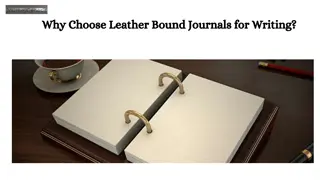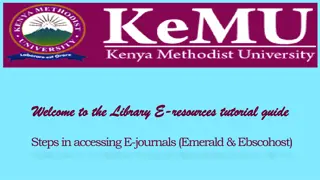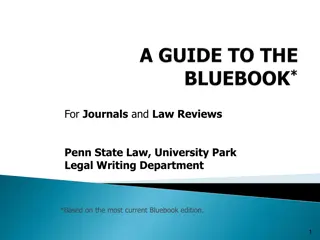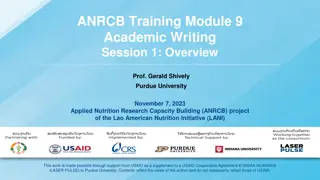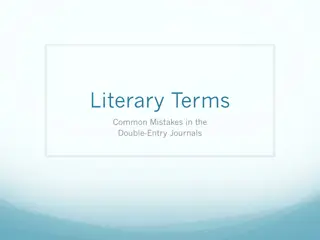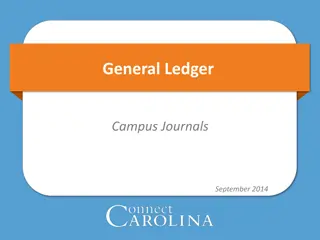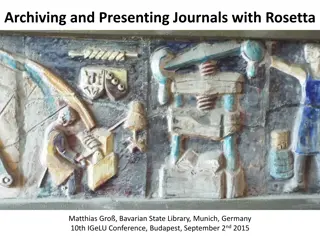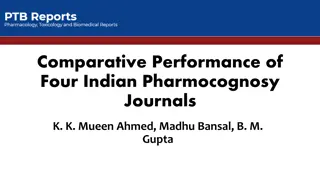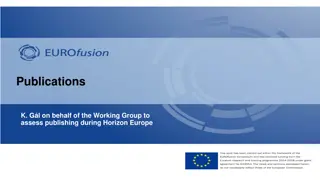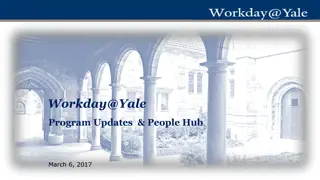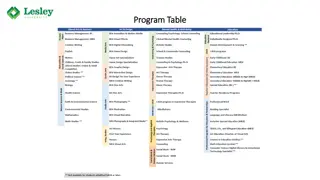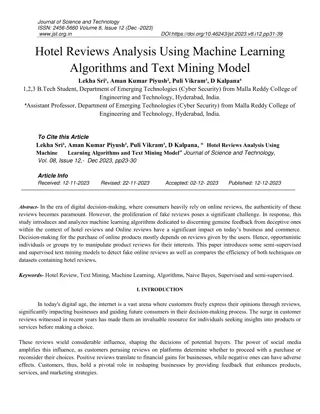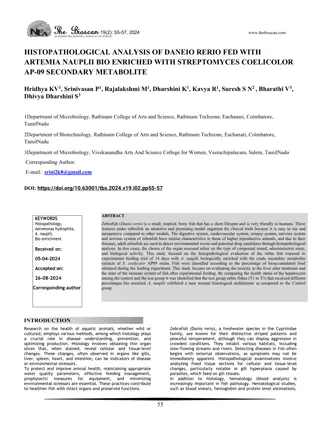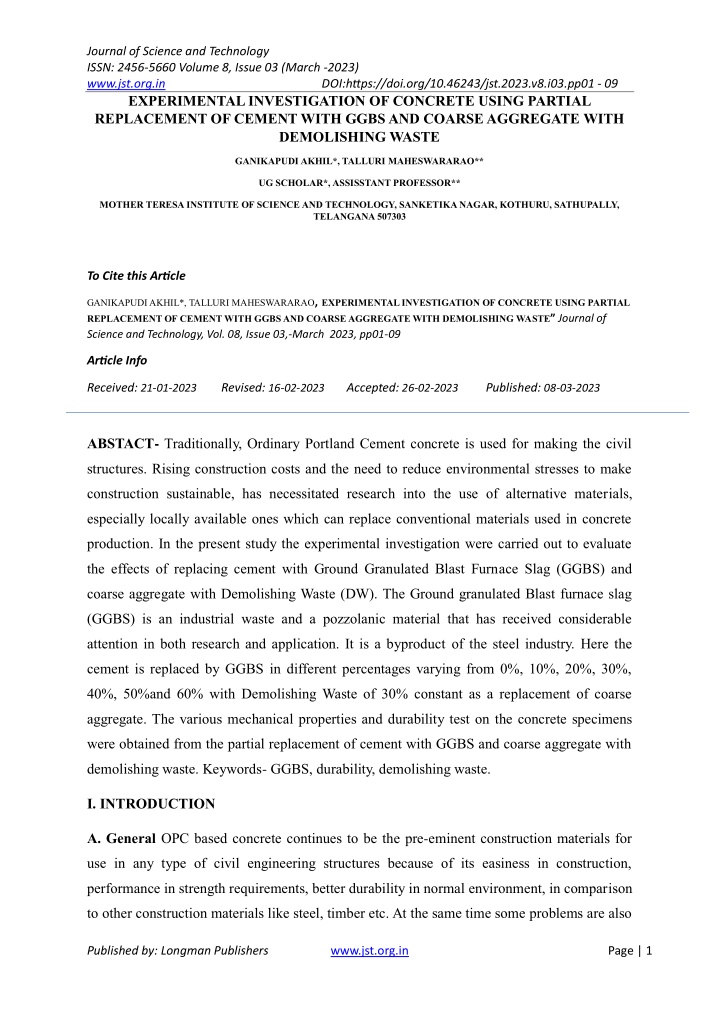
Academic journals
Academic journals are periodicals that publish scholarly research in specific fields of study. They serve as platforms for researchers, scholars, and experts to share new findings, theories, methodologies, and analyses with the academic community. Ea
Download Presentation

Please find below an Image/Link to download the presentation.
The content on the website is provided AS IS for your information and personal use only. It may not be sold, licensed, or shared on other websites without obtaining consent from the author. If you encounter any issues during the download, it is possible that the publisher has removed the file from their server.
You are allowed to download the files provided on this website for personal or commercial use, subject to the condition that they are used lawfully. All files are the property of their respective owners.
The content on the website is provided AS IS for your information and personal use only. It may not be sold, licensed, or shared on other websites without obtaining consent from the author.
E N D
Presentation Transcript
Journal of Science and Technology ISSN: 2456-5660 Volume 8, Issue 03 (March -2023) www.jst.org.in DOI:https://doi.org/10.46243/jst.2023.v8.i03.pp01 - 09 EXPERIMENTAL INVESTIGATION OF CONCRETE USING PARTIAL REPLACEMENT OF CEMENT WITH GGBS AND COARSE AGGREGATE WITH DEMOLISHING WASTE GANIKAPUDI AKHIL*, TALLURI MAHESWARARAO** UG SCHOLAR*, ASSISSTANT PROFESSOR** MOTHER TERESA INSTITUTE OF SCIENCE AND TECHNOLOGY, SANKETIKA NAGAR, KOTHURU, SATHUPALLY, TELANGANA 507303 To Cite this Article GANIKAPUDI AKHIL*, TALLURI MAHESWARARAO,EXPERIMENTAL INVESTIGATION OF CONCRETE USING PARTIAL REPLACEMENT OF CEMENT WITH GGBS AND COARSE AGGREGATE WITH DEMOLISHING WASTE Journal of Science and Technology, Vol. 08, Issue 03,-March 2023, pp01-09 Article Info Received: 21-01-2023 Revised: 16-02-2023 Accepted: 26-02-2023 Published: 08-03-2023 ABSTACT- Traditionally, Ordinary Portland Cement concrete is used for making the civil structures. Rising construction costs and the need to reduce environmental stresses to make construction sustainable, has necessitated research into the use of alternative materials, especially locally available ones which can replace conventional materials used in concrete production. In the present study the experimental investigation were carried out to evaluate the effects of replacing cement with Ground Granulated Blast Furnace Slag (GGBS) and coarse aggregate with Demolishing Waste (DW). The Ground granulated Blast furnace slag (GGBS) is an industrial waste and a pozzolanic material that has received considerable attention in both research and application. It is a byproduct of the steel industry. Here the cement is replaced by GGBS in different percentages varying from 0%, 10%, 20%, 30%, 40%, 50%and 60% with Demolishing Waste of 30% constant as a replacement of coarse aggregate. The various mechanical properties and durability test on the concrete specimens were obtained from the partial replacement of cement with GGBS and coarse aggregate with demolishing waste. Keywords- GGBS, durability, demolishing waste. I. INTRODUCTION A. General OPC based concrete continues to be the pre-eminent construction materials for use in any type of civil engineering structures because of its easiness in construction, performance in strength requirements, better durability in normal environment, in comparison to other construction materials like steel, timber etc. At the same time some problems are also Published by: Longman Publishers www.jst.org.in Page | 1
Journal of Science and Technology ISSN: 2456-5660 Volume 8, Issue 03 (March -2023) www.jst.org.in DOI:https://doi.org/10.46243/jst.2023.v8.i03.pp01 - 09 associated with this. First is environmental pollution and large energy requirement in the production of OPC. Production of one tonne OPC required approximate 4.0 Joule energy and produced approximate one tonne carbon dioxide gas in the environment. At present the cement industries produced approximate 7% of total carbon dioxide produced in the world, which is very alarming to our protective Ozone layer. Second problem is the lower durability in aggressive environment. Concrete with OPC, which performed, very well over a period of about 100 years in the normal environment showed substantial damage within a few years of construction in the aggressive environment. Use of mineral admixtures like Ground Granulated Blast Furnace Slag (GGBS), Silica Fume (SF), and Fly Ash (FA) etc. in concrete may be the better solution in above conditions. These admixtures also offer benefits with respect to the cost of concrete Rising construction costs and the need to reduce environmental stresses to make construction sustainable, has necessitated research into the use of alternative materials, especially locally available ones which can replace conventional ones used in concrete production. Huge quantities of construction materials are required in developing countries due to continued infrastructural growth and also huge quantities of construction and demolition wastes are generated every year in developing countries like India. The disposal of this waste is a very serious problem because on one side it requires huge space for its disposal while on the other side it pollutes the environment. It is also necessary to protect and preserve the natural resources like stone, sand etc. Continuous use of natural resources, like river and sand is another major problem and this increases the depth of river bed resulting in drafts and also changing the climatic conditions. So, the sustainable concept was introduced in construction industry due to growing concern about the future of our planet, because it is a huge consumer of natural resources as well as waste producer. The use of demolishing waste in concrete could have a promising future in construction industry as partial or full substitute for either fine aggregate or coarse aggregates. This study not only reducing cost of construction. Also safe disposals of waste material can be achieved. The use of cheaper material without loss of performance is very crucial to the growth of development of countries. Blast furnace slag cements are in use for a reasonably long period due to the overall economy in their production as well as their improved performance characteristics in aggressive environments. Also, the use of pozzolans as additives to cement, and more recently to concrete, is well accepted in practice. Ground Granulated Blast Furnace Slag (GGBS) is a byproduct of the steel industry. GGBS is produced when molten slag is Published by: Longman Publishers www.jst.org.in Page | 2
Journal of Science and Technology ISSN: 2456-5660 Volume 8, Issue 03 (March -2023) www.jst.org.in DOI:https://doi.org/10.46243/jst.2023.v8.i03.pp01 - 09 quenched rapidly using water jets, which Granulated Blast Furnace Slag is advantageous over various other cementing materials because of the following reasons:- Non-hazardous and non-metallic waste of the Iron industry. Eco-friendly and useful for construction work. Helps to improve the properties of concrete like compressive strength, workability etc. Low cost and easily available. In India, about 7.8 million tons of GGBS is produced per year. All the Blast Furnace Slags are obtained by quenching the molten slag by using high power water jet, making 100% glassy slag granules of 0.4 mm size. Ground Granulated Blast Furnace Slag is used as an admixture in making concrete. Now in India, since GGBS is available separately, its use as an admixture should become more common. The replacement of cement with GGBS will reduce the unit water content necessary to obtain the same slump. This reduction of unit water content will be more pronounced with increase in slag content and also on the fineness of slag. This is because of the surface configuration and particle shape of slag being different than cement particle. In addition, water used for mixing is not immediately lost, as the surface hydration of slag is slightly slower than that of cement. Ground Granulated Blast Furnace Slag blended with OPC gives lower strength in early stages of concreting and gains strength slower than normal OPC concrete. Thus, concrete with GGBS have greater place-ability and workability. Demolishing waste consists mainly of wood products, tiles, asphalt, drywall (gypsum), and masonry (e.g., concrete, bricks). Other notable components include metals, plastics, earth, shingles, and insulation. Demolishing wastes are categorized in a variety of ways, and each category produces wastes with different composition and characteristics. For example, road construction and demolishing waste differs from bridge waste, which differs from building waste. Whereas road construction and demolishing waste generates large quantities of few different waste items (mainly asphalt and concrete), building construction and demolishing waste generates many different waste items in smaller amounts (with wood as the largest single item). Within the category of building demolishing waste, the size and type of the building (e.g., an apartment building versus a single-family house) affects the composition of the waste. Even for one building type, the waste generated depends on the activity conducted. B. Hydration of GGBS Hydration products of GGBS are poorly crystalline Calcium Silicate Hydrate broadly similar to that formed from hydration of OPC, but with lower Ca/Si ratio. Due to lower Ca/ Si ratio, these hydrates have more alkali retention capacity. Hydration products of GGBS effectively fill up Published by: Longman Publishers www.jst.org.in Page | 3
Journal of Science and Technology ISSN: 2456-5660 Volume 8, Issue 03 (March -2023) www.jst.org.in DOI:https://doi.org/10.46243/jst.2023.v8.i03.pp01 - 09 the pores and increase the strength and durability of concrete. GGBS requires activation to initiate hydration and the availability of a medium for continuing the hydration process. Slag hydration can be activated by using alkalies, lime, sulphate etc. (Chemically activation), or by fine grinding (Mechanically activation) or by increasing temperature of concrete (Thermal activation). Various alkalies activators like Sodium hydroxide, Sodium carbonate, Sodium sulphate, Sodium silicate (Water glass) etc. can be used for slag. Water glass activated slag produced most cross-linked structures that results in increased mechanical strength of hydration products, while Sodium hydroxide make hydration process of slag more intensive Due to higher activation energy of blast furnace slag relative to OPC, it has advantage of thermal activation on its hydration. C. Objectives Present experimental work explores the possibility of using GGBS and Demolishing waste as replacement of cement and coarse aggregate in concrete. The main objective of this study is To study the workability, physical and chemical properties of ingredients used and to develop a suitable mix proportion. To study the mechanical properties such as compressive strength, splitting tensile strength and flexural strength by casting cubes and cylindrical specimen. To check the durability of cast specimen under acid, alkali environment and check the corrosion resistance. D. Methodology Raw materials procurement from available sources Determination of material properties Develop mix design Development of mix proportion with addition of GGBS in different proportions Workability study of developed mixes Casting the specimens Testing the specimens Comparison of results to arrive at conclusion Published by: Longman Publishers www.jst.org.in Page | 4
Journal of Science and Technology ISSN: 2456-5660 Volume 8, Issue 03 (March -2023) www.jst.org.in DOI:https://doi.org/10.46243/jst.2023.v8.i03.pp01 - 09 II. EXPERIMENTAL INVESTIGATION The aim of the experimental investigation is to ascertain and compare the improvement in the performance of concrete by the partial replacement of cement with GGBS and coarse aggregate with demolishing waste thereby to arrive at the optimum replacement percentageof GGBS and to study durability of concrete mix. This study deals with the experimental programmes which include material characterisation, mix design and calculating the number of specimens to be tested A. Materials used The various materials used in the experiment are Cement: Ordinary Portland Cement (53 grade). Ground Granulated Blast Furnace Slag (GGBS): In this study, GGBS will be used as a replacement of cement varying at levels of 10%, 20%, 30%, 40%, 50% and 60%. Fine aggregate: M-sand with 4.75 mm maximum size will be used as fine aggregate. Coarse aggregate: Crushed stone with 12 20 mm size will be used as coarse aggregate. Demolishing waste : In this study demolishing waste is used as a replacement of coarse aggregate with 30% of volume of concrete Potable water B. Test on constituent materials Cement: Ordinary Portland Cement of 53 grade, conforming to IS: 12269-1987 was used. Different laboratory tests were conducted on cement to determine standard consistency and initial and final setting time as per IS: 4031-1988. Tests were conducted in the laboratory. The specific gravity was obtained as 2.7 and standard consistency 36%. The initial and final setting time was obtained as 80 minutes and 410 minutes respectively. The GGBS is a by-product in the manufacture of iron and the amounts of iron and slag obtained are of the same order. Iron ore, coke and limestone are fed into the furnace and the resulting molten slag floats above the molten iron at a temperature of about 1500 C to 1600 C. After the molten iron is tapped off, the remaining molten slag, which consists of mainly siliceous and aluminous residue is then water-quenched rapidly, resulting in the formation of a glassy granulate. This glassy granulate is dried and ground to the required size, which is known as GGBS. The GGBS required in this study obtained from steel plant, Karnataka. The GGBS which is used passes, 97.4% through 90 micron sieve. The specific gravity was obtained as 2.7 The aim of this work is to ascertain the performance of concrete mix containing GGBS as replacement of OPC and to compare it with the plain concrete mix of 25 grades. Published by: Longman Publishers www.jst.org.in Page | 5
Journal of Science and Technology ISSN: 2456-5660 Volume 8, Issue 03 (March -2023) www.jst.org.in DOI:https://doi.org/10.46243/jst.2023.v8.i03.pp01 - 09 Fig: GBBS Fine Aggregate: Commercially available manufactured sand passing through 4.75mm IS sieve and conforming to grading zone II of IS: 383-1970 was used for experiment. Sieve analysis was done to determine the fineness modulus and grain size distribution of M sand. Fineness modulus of fine aggregate was obtained as 2.8.the specific gravity was obtained as 2.4 Coarse Aggregate :Coarse aggregates that are used for this study consists of locally supplied granite type coarse aggregate of nominal size 20 mm. As per IS: 2386 (part III) 1963, laboratory tests were conducted on coarse aggregate to determine the different physical properties. The specific gravity and fineness modulus were obtained as 2.9 and 5.7 respectively. Demolishing waste :In the present work Demolishing waste was collected from locally available construction site. It consists of concrete blocks, brick, masonry, tiles etc. Demolishing waste maximum of 20 mm size was mixed and used. . Physical properties such as specific gravity and fineness modulus were obtained as 2.5 and 6.5 respectively. Water \:Drinking water directly drawn from the college water supply line is to be used for the entire casting work C. Mix design M25 mix was designed as per IS10262:2009 and the mix proportion was obtained as 1:1.66:2.88. Water-cement ratio was 0.45. Seven mixes were made namely GB0, GB 10, GB 20, GB 30, GB 40, GB 50 and GB 60 to determine mechanical properties and properties of fresh concrete. GB 0 with 0% and 30% demolishing waste is considered as control mix. In the other six mixes GGBS replacing cement is varied t levels of 10%, 20%, 30%, 40%, 50% and 60%. The mix corresponding to 60% replacement of cement by GGBS is to be taken as the final mix. The mix other than control mix and final mix that gives the maximum values of mechanical properties is considered as the nominal mix. Quantities of ingredients are given in Table 1 Published by: Longman Publishers www.jst.org.in Page | 6
Journal of Science and Technology ISSN: 2456-5660 Volume 8, Issue 03 (March -2023) www.jst.org.in DOI:https://doi.org/10.46243/jst.2023.v8.i03.pp01 - 09 D Durability study 1. General The durability of concrete is the ability to resist weathering action, chemical attack, abrasion, or any process of deterioration. Durable concrete will retain its original form, quality, and serviceability when exposed to its environment. For the study of durability of concrete the test conducted were Acid resistance test (Sulphuric Acid attack), Alkalinity test (Sodium Hydroxide attack), Sulphate attack test, Seawater attack test. 2. Acid attack test Concrete is susceptible to attack by sulphuric acid produced from either sewage or sulphur dioxide present in the atmosphere of industrial cities. This attack is due to the high alkalinity of Portland cement concrete, which can be attacked by other acids as well. Sulphuric acid is particularly corrosive due to the sulphate ion participating in sulphate attack. In this test the effect of sulphuric acid on the durability of concrete specimen was determined. For this test the cube specimens of 100mm 100mm 100mm was used to measure the reduction in compressive strength and mass loss with respect to normal water cured specimens. The specimens were exposed to 5% sulphuric acid solution. This solution was prepared by diluting the concentrated sulphuric acid by normal water. The specimens were immersed in the solution after removing from the mould. Then the weight and compressive strength were compared with normal cured specimens in 28 days, 56 days and 90 days 3. Sulphate Attack Sulphate attack is a common form of concrete deterioration. It occurs when concrete comes in contact with water containing sulphates (SO4). Sulphates can be found in some soils (especially when arid conditions exist), in seawater, and in wastewater Published by: Longman Publishers www.jst.org.in Page | 7
Journal of Science and Technology ISSN: 2456-5660 Volume 8, Issue 03 (March -2023) www.jst.org.in DOI:https://doi.org/10.46243/jst.2023.v8.i03.pp01 - 09 treatment plants. Sulphate attack in concrete can be external or internal. External attack is due to the penetration of sulphate in solutions. CONCLUSION In the present study, an attempt was made to study the effect of partial replacement of cement with GGBS and coarse aggregate with demolishing waste. From the preliminary investigation conducted GB 40 was selected as the optimum mix based on compressive strength. Workability test was conducted for all mixes. Mechanical properties like compressive strength of cube, splitting tensile strength, flexural strength were checked for all the sevan mixes, and the durability properties were checked for three mixes, ie GB 0,GB 40 and GB 60. The obtained results were compared with the control mix (GB 0) Based on the limited experimental investigation the following conclusions were derived Workability increased with increase in GGBS content. Maximum workability was obtained at 60 % of replacement of cement with GGBS. Cement with 40% replacement (GB 40) showed better mechanical properties in the hardened state. Compressive strength increased upto 40% of replacement with GGBS, and then decreased at all ages. The increase in compressive strength at 28th day of GB 40 was about 13.47% than control mix (GB 0). The splitting tensile strength of cylinder was maximum for 40% of replacement. The percentage of increase in splitting tensile strength of GB 40 was about 51.90% than GB0. The flexural strength of beam was maximum for GB 40.The percentage of increase in strength of GB 40 was about 80% than GB 0. GGBS concrete had less durability property in acid test. After 90 days exposure in sulphuric acid solution the compressive strength of GB 60 was reduced. Percentage weight loss was much higher for GB 60. On curing in NaOH solution, the percentage strength loss for GB 60 was about 25.94% at 90 days. The weight loss was lower for the GGBS concrete compared to control mix. So GGBS concrete was durable in alkaline solution compared to control mix. The GGBS concrete reduced the sulphate attack as compared with control mix. The slag present in the mix reduced concrete permeability, and made it harder for sulphates to penetrate into concrete. Published by: Longman Publishers www.jst.org.in Page | 8
Journal of Science and Technology ISSN: 2456-5660 Volume 8, Issue 03 (March -2023) www.jst.org.in DOI:https://doi.org/10.46243/jst.2023.v8.i03.pp01 - 09 All mixes which were subjected to sea water attack showed better durability properties in terms of compressive strength. REFERENCES [1] A.H.L.Swaroop, et.al. (2013), Durability studies on concrete with fly ash & GGBS, International Journal of Engineering Research and Applications, 3, 285-289. [2] A. Oner, et.al. (2007), An experimental study on optimum usage of GGBS for the compressive strength of concrete, Cement & Concrete Composites, 29, 505 514. [3] D.D.Higgins (2003), Increased sulfate resistance of GGBS concrete in the presence of carbonate, Cement &Concrete Composites, 25, 913 919. [4] Isa Yuksel, et.al. (2011), Influence of high temperature on the properties of concretes made with industrial by-products as fine aggregate replacement, Construction and Building Materials 25, 967 972. [5] K. Ganesh Babu, et.al. (2000), Efficiency of GGBS in Concrete, Cement and Concrete Research, 30, 1031 1036. [6] Kyong Yun Yeau, et.al. (2005), An experimental study on corrosion resistance of concrete with ground granulate blast- furnace slag, Cement and Concrete Research, 35, 1391 1399. [7] Pazhani.K, et.al. (2010), Study on durability of high performance concrete with industrial wastes, ATI - Applied Technologies & Innovations Volume, 2, 1804-1191. [8] Saud Al-Otaibi, et.al. (2008), Durability of concrete incorporating GGBS activated by water-glass, Construction and Building Materials, 22, 2059 2067. [9] V.S.Tamilarasan, et.al (2012), Workability studies on concrete with GGBS as a replacement material for cement with and without superplasticiser, International research of advanced research in Engineering and Technology, 3, 11-21. [10] Venu Malagavelli, (2010), High performance concrete with GGBS and robo sand, International Journal of Engineering Science and Technology, 2, 5107-5113 Published by: Longman Publishers www.jst.org.in Page | 9

